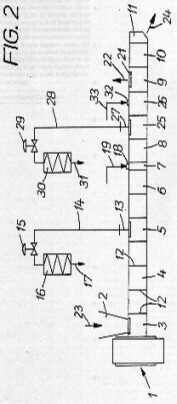| |
A raw polyamide-6 with a caprolactam content of 9.3 weight % is purified in an equal-twist twin-screw kneader, Model ZSK 40, in accordance with FIG. 2 by means of solvent extraction with water. At a flow rate of 22 kg/h of the mixture of substances, 8 kg/h of water are supplied to the extruder at a pressure of 4 bar absolute via the steam feed line 19 and removed to a great extent from the first low pressure Zone 5 at a pressure of 3 bar absolute. A second extraction follows the first extraction. In the process, water is supplied to the extruder via the steam feed line 33 at a pressure of 2 bar abs., whereupon the added water flows opposite the polymer melt, in the process is increasingly charged with residual contaminants to be extracted and is removed from the second low pressure zone 25 at atmospheric pressure. A portion of the added water is absorbed by the polymer melt and, together with the possibly remaining small amounts of contaminants, is removed in the succeeding last low pressure zone 9 at a vacuum of 1 mbar. Subsequently, the purified polymer melt 24 is pelletized and analyzed as to caprolactam content. The caprolactam content could be reduced to 640 mg/kg, corresponding to a 99.3% reduction of caprolactam.
In accordance with the invention, the extracted
Caprolactam always remains dissolved in the aqueous phase and does
not lead to obstructions of pipelines. Accordingly, a trouble-free,
reliable, continuous operation is assured.  |
|
















